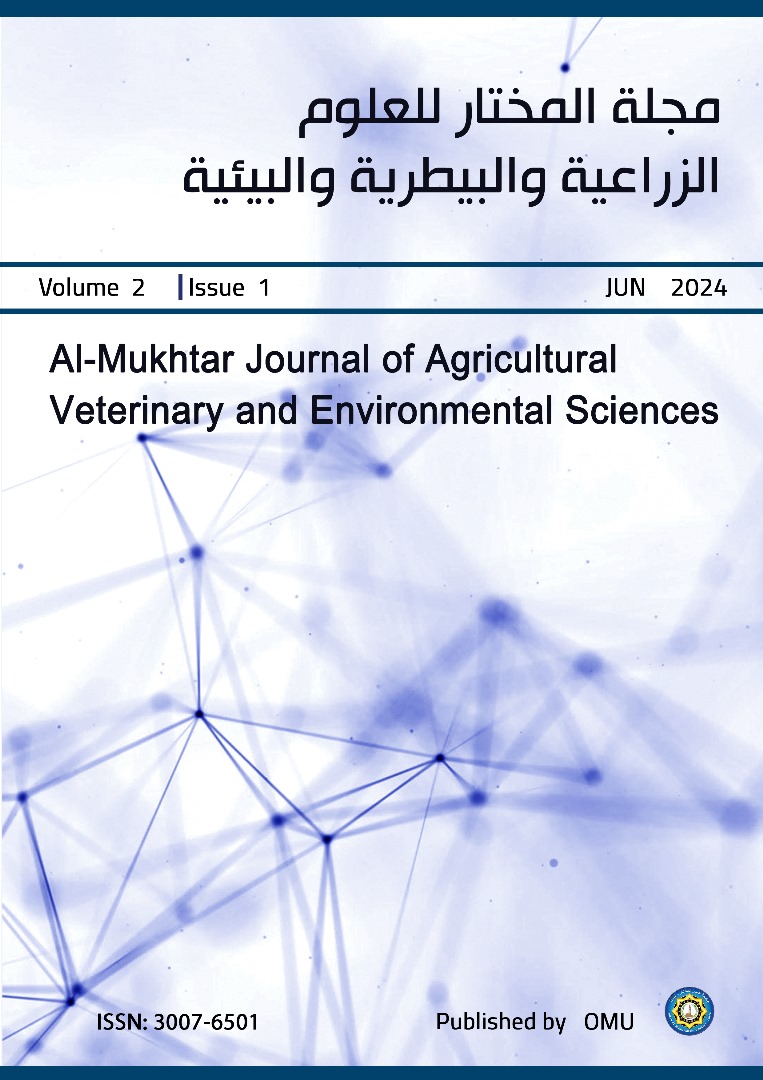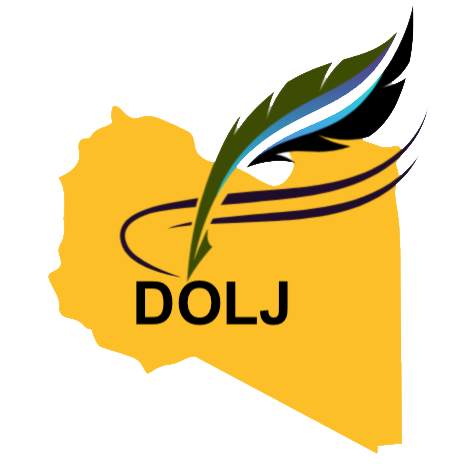Estimating reference evapotranspiration for Shahat region in Libya using genetic programming
DOI:
https://doi.org/10.54172/2ma3bd67Keywords:
Reference Evapotranspiration, Genetic Programming, FAO Penman-Monteith Equation, Shahat RegionAbstract
This study was conducted to estimate the reference evapotranspiration (ETo) for Shahat region in Libya using the genetic programming (GP) model compared to the FAO Penman-Monteith equation (FPM56). The climatic data of Shahat Meteorological Station was used for the period from 1963 to 1999. Six different combinations of available meteorological variables were used, such as the average air temperature (Tmean), the average relative humidity (RHmean), and the extraterrestrial radiation (Ra). The latter is calculated as a function of the location and time during the year. The GP model was trained using 70% of the climatic data and tested using the remaining 30%. The values of the statistical indicators obtained in this study showed that the root mean square error (RMSE), coefficient of determination (R2), and Nash-Sutcliffe coefficient of efficiency (NSE) ranged between 0.26 and 0.98 (mm.day-1); 0.67 and 0.98; 0.66 and 0.98, respectively during the testing period. Therefore, GP models represent a great option to estimate ETo, when climatic data are scarce.
References
Adamala, S., Raghuwanshi, N., Mishra, A., & Singh, R. (2019). Generalized wavelet neural networks for evapotranspiration modeling in India. ISH Journal of Hydraulic Engineering, 25(2), 119-131.
Adeloye, A. J., Rustum, R., & Kariyama, I. D. (2012). Neural computing modeling of the reference crop evapotranspiration. Environmental modelling & software, 29(1), 61-73.
Allen, R. G. (2000). REF-ET: Reference Evapotranspiration calculation software for FAO and ASCE standarized equatioin Version 3.1.16 for Windows. University of Idaho Research and Extension Center, Kimberly, Idaho
Allen, R. G., Pereira, L. S., Howell, T. A., & Jensen, M. E. (2011). Evapotranspiration information reporting: I. Factors governing measurement accuracy. Agricultural Water Management, 98(6), 899-920.
Allen, R. G., Pereira, L. S., Raes, D., & Smith, M. (1998). Crop evapotranspiration: guidelines for computing crop water requirements. FAO Irrigation and Drainage Paper no. 56, Rome, Italy.
Chia, M. Y., Huang, Y. F., Koo, C. H., & Fung, K. F. (2020). Recent advances in evapotranspiration estimation using artificial intelligence approaches with a focus on hybridization techniques—a review. Agronomy, 10(1), 101.
Egipto, R., Aquino, A., Costa, J. M., & Andújar, J. M. (2023). Predicting Crop Evapotranspiration under Non-Standard Conditions Using Machine Learning Algorithms, a Case Study for Vitis vinifera L. cv Tempranillo. Agronomy, 13(10), 2463.
Fogel, L. J., Owens, A. J., & Walsh, M. J. (1966). Intelligent decision making through a simulation of evolution. Behavioral science, 11(4), 253-272.
Guven, A., Aytek, A., Yuce, M. I., & Aksoy, H. (2008). Genetic programming‐based empirical model for daily reference evapotranspiration estimation. Clean–Soil, Air, Water, 36(10‐11), 905-912.
Holland, J. (1975). Adaption in Natural and Artificial Systems. Ann Arbor: University of Michigan, Press, 13.
Hrnjica, B. (2018). GPdotNET Tree based genetic programming tool, open source project. http://github.com/bhrnjica/gpdotnet
Huang, G., Wu, L., Ma, X., Zhang, W., Fan, J., Yu, X., . . . Zhou, H. (2019). Evaluation of CatBoost method for prediction of reference evapotranspiration in humid regions. Journal of Hydrology, 574, 1029-1041.
Kennedy, J. B., & Neville, A. M. (1986). Basic Statistical Methods for Engineers and Scientists (3rd ed.).
Koza, J. R. (1992). On the programming of computers by means of natural selection. In Genetic programming.
Koza, J. R. (1994). Genetic programming as a means for programming computers by natural selection. Statistics and computing, 4, 87-112.
Liu, Q., Wu, Z., Cui, N., Zhang, W., Wang, Y., Hu, X., . . . Zheng, S. (2022). Genetic algorithm-optimized extreme learning machine model for estimating daily reference evapotranspiration in Southwest China. Atmosphere, 13(6), 971.
Nash, J. E., & Sutcliffe, J. V. (1970). River flow forecasting through conceptual models part I—A discussion of principles. Journal of Hydrology, 10(3), 282-290.
Poli, R., Langdon, W., & McPhee, N. (2008). A field guide to genetic programming, Riccardo Poli, William B. Langdon, and Nicholas Freitag McPhee.
Raza, A., Fahmeed, R., Syed, N. R., Katipoğlu, O. M., Zubair, M., Alshehri, F., & Elbeltagi, A. (2023). Performance Evaluation of Five Machine Learning Algorithms for Estimating Reference Evapotranspiration in an Arid Climate. Water, 15(21), 3822.
Schwefel, H.-P. (1981). Numerical optimization of computer models. John Wiley & Sons, Inc.
Spontoni, T. A., Ventura, T. M., Palácios, R. S., Curado, L. F., Fernandes, W. A., Capistrano, V. B., . . . Rodrigues, T. R. (2023). Evaluation and modelling of reference evapotranspiration using different machine learning techniques for a brazilian tropical savanna. Agronomy, 13(8), 2056.
Wu, L., Zhou, H., Ma, X., Fan, J., & Zhang, F. (2019). Daily reference evapotranspiration prediction based on hybridized extreme learning machine model with bio-inspired optimization algorithms: Application in contrasting climates of China. Journal of Hydrology, 577, 123960.
Yamaç, S. S., & Todorovic, M. (2020). Estimation of daily potato crop evapotranspiration using three different machine learning algorithms and four scenarios of available meteorological data. Agricultural Water Management, 228, 105875.
Downloads
Published
Issue
Section
License
Copyright (c) 2024 Osama A. Abdelatty , Mohamed A. Momen (Author)

This work is licensed under a Creative Commons Attribution-NonCommercial 4.0 International License.













